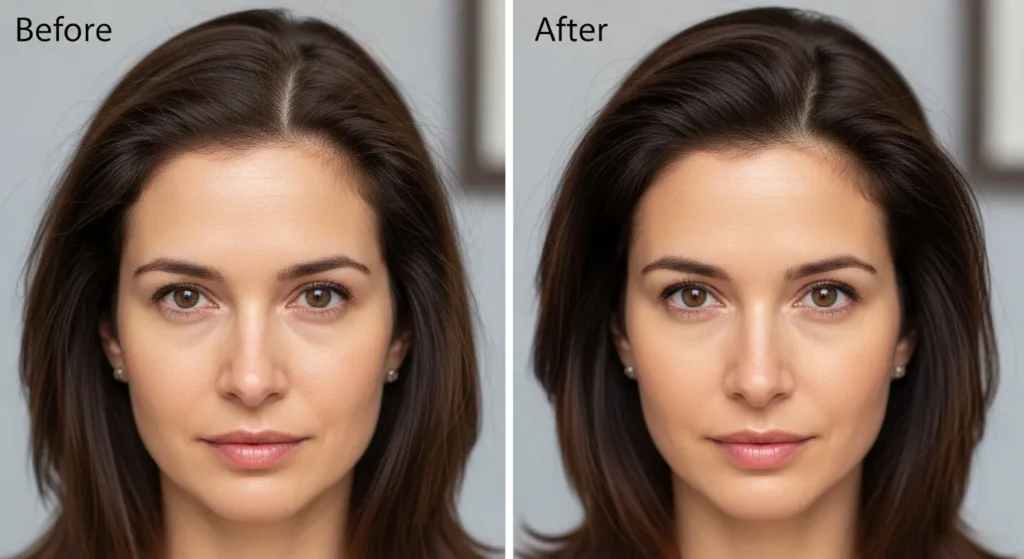Dealing with hair loss can be frustrating, especially when you’re unsure if any treatment will really work. This blog dives into hair loss before and after transformations, showing what’s possible with proven treatments like Finasteride, PRP, and hair transplants.
You’ll see real-world examples, expert advice, and timelines that help set realistic expectations. Whether you’re just beginning or tracking progress, this guide helps you make confident, informed choices backed by medical expertise.
Understanding Hair Loss & Transformation Journeys

Types of Hair Loss
Before looking at transformations, it’s important to understand why hair loss happens. Common causes include:
- Androgenetic Alopecia (Male/Female Pattern Baldness): The most common type, linked to genetics and hormones.
- Alopecia Areata: An autoimmune condition causing patchy hair loss.
- Telogen Effluvium: Temporary shedding often triggered by stress, illness, or hormonal changes.
Why “Before and After” Results Matter
Before and after photos provide visual proof of a treatment’s effectiveness. But keep in mind:
- Lighting, angles, and timeframes can be manipulated.
- Focus on medical case studies and verified clinic galleries.
- Pay attention to texture, density, and hairline progression—not just length.
Realistic Expectations
Not every product will yield miraculous regrowth. Consistency, treatment type, genetics, and age all play key roles in how your results unfold over time.
Real “Hair Loss Before and After” Case Studies
Finasteride (Oral & Topical): 3 to 12-Month Results
Finasteride blocks DHT, the hormone responsible for pattern hair loss.
Timeline of Results:
- 3 Months: Shedding slows, minor density improvement
- 6 Months: Visible regrowth in crown and vertex
- 12 Months: Significant thickening, fuller appearance
PRP Therapy: Platelet-Rich Plasma Before & After
PRP uses your blood’s growth factors to stimulate dormant follicles.
- Typically done in 3 sessions, 1 month apart.
- Most patients see reduced shedding after 1–2 months.
- Noticeable thickening by 3–6 months.

Pro Tip: Results improve when PRP is combined with microneedling or Minoxidil
Low-Level Laser Therapy (LLLT)
- Red light therapy caps and helmets can improve hair density.
- Mixed clinical evidence: best for early-stage thinning.
- Requires consistent daily/weekly use for 4–6 months.
Female Hair Loss Transformations
- Female pattern baldness often presents as diffuse thinning.
- Hormonal factors (like PCOS or menopause) can contribute.
- “Before and after” transformations often require a multifaceted approach, including Minoxidil, PRP, and supplements.
How to Prepare & Track Your Own “Before and After”
Take Consistent Progress Photos
- Use the same lighting, background, and angles monthly.
- Front, side, crown, and vertex views are essential.
Track Metrics Beyond Photos
- Hair strand count (via comb test)
- Scalp visibility and texture
- Self-assessed confidence levels
Apps & Journals for Progress
Apps like HairJournal or custom Google Sheets help track timelines, treatments, and perceived improvement.
Choosing the Best Hair Loss Solution
Medication Options
- Finasteride: Best for men; reduces DHT
- Minoxidil (Topical/Foam): Boosts blood flow, good for men & women
- Topical Finasteride/Minoxidil: Fewer side effects, good combo therapy
PRP Therapy
- Ideal for early-to-moderate thinning
- No downtime
- Works well when combined with other treatments

LLLT
- Suitable for non-invasive, long-term use
- Devices like Capillus and iRestore are FDA-cleared
- Requires patience and regular sessions
Hair Transplant
- Best for advanced hair loss
- Natural, permanent results when done by ABHRS-certified surgeons
Combination Therapies
Stacking treatments often yields the best results. Example:
- Finasteride + PRP
- Minoxidil + Microneedling
- Hair Transplant + LLLT for maintenance
Timeline & Recovery
| Treatment | Initial Signs | Noticeable Growth | Final Results |
|---|---|---|---|
| Finasteride | 3 months | 6 months | 12 months |
| PRP | 1–2 months | 3 months | 6–8 months |
| LLLT | 2 months | 4–6 months | 9–12 months |
| Transplant | 3–4 months | 6–9 months | 12–18 months |
Factors That Affect Progress
- Age
- Genetics
- Scalp health
- Nutritional support
- Compliance with regimen
Expert Advice: Scalp Care Tips
- Avoid sweating, harsh shampoos, and tight headwear during treatment periods.
- Use sulfate-free, pH-balanced shampoos.
- Stay hydrated and support follicles with biotin or vitamin D.
Additional References:
- Norwood Scale for male pattern baldness
- Clinical studies on PRP, Finasteride efficacy
- FDA resources for LLLT device safety
FAQs
1. How long until I see hair regrowth?
Most treatments take 3 to 6 months for visible changes. Hair transplants may take 12+ months for full results.
2. Will results last if I stop treatment?
Medications like Finasteride or Minoxidil must be continued to maintain results. Hair transplants are permanent, but the surrounding native hair may still thin.
3. Is PRP safe for everyone?
Yes, especially because it’s autologous (from your blood). Minor swelling or redness may occur temporarily.
4. Can women get hair transplants or use Finasteride?
Women can undergo transplants. However, oral Finasteride is generally not recommended for women of childbearing age.
5. Does red light therapy work?
Studies show LLLT can improve density in early-stage hair loss, but consistency is crucial.
6. What’s the best way to track my “before and after”?
Use monthly photos, journal entries, and scalp assessments to track density and texture over time.
Take Your Next Step
Ready to start your hair loss before and after journey? Book a consultation with Dr. Rana Irfan in Islamabad, Pakistan’s ABHRS-certified hair transplant expert. Whether you’re considering PRP, medication, or transplant, get a customized plan backed by science and experience.
📍 Visit our clinic or schedule a virtual consultation today.
